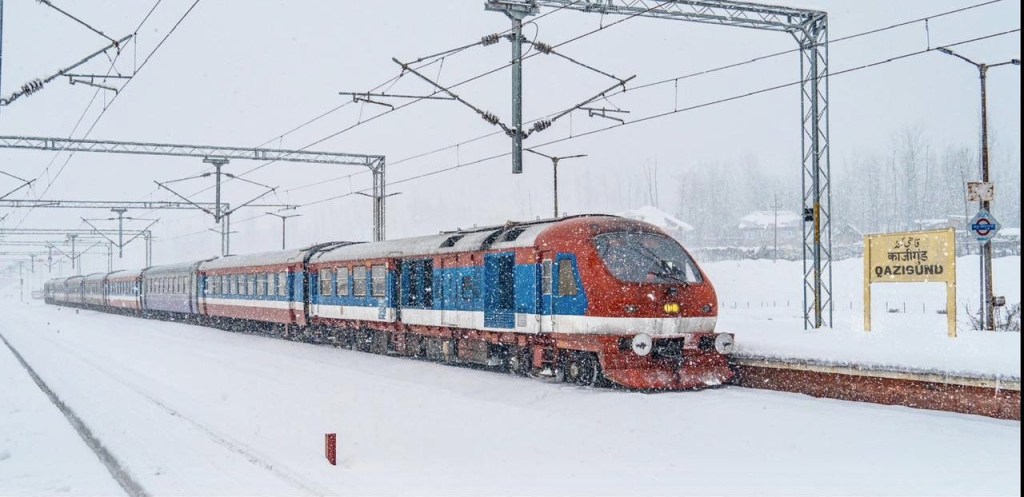February 20, 2024, registered itself as a red-letter day in the history of Indian Railways, as country’s longest transportation tunnel namely ‘T-50’ on Udhampur-Srinagar-Baramulla Rail Link (USBRL) was dedicated by Prime Minister Narendra Modi when he flagged off the first electrified trains of the Kashmir valley.
Two electrified trains simultaneously, one from Srinagar to Sangaldan in the down direction and the other from Sangaldan to Srinagar in the up direction started service, a railway official said.
On Tuesday, the Prime Minister mentioned the expansion work of connecting Kashmir to Kanyakumari by rail, and the new trains running from Srinagar to Sangaldan and Sangaldan to Baramulla.
“The day is not far when people will be able to travel across the country by taking a train from Kashmir,” Modi asserted.
The tunnel, which is 12.77 km long and known as T-50, falls between the Khari-Sumber section, the official said while adding that the prime minister also inaugurated the 48.1-km-long Banihal-Khari-Sumber-Sangaldan section of USBRL.
As per Northern Railway (NR), trains can now run from Baramulla to Sangaldan via Banihal, which used to be the last or originating station earlier.
Demystifying T-50 tunnel
T-50 is one of the most challenging tunnels on the Banihal-Khari-Sumber-Sangadal section of USBRL.
The survey work of the tunnel commenced around 1996 but the tender was awarded in December 2013 so it took around 10 years to operationalise it railway officials associated with the project, railway officials associated with the project mentioned.
“All safety measures have been taken inside the tunnel for emergencies. An escape tunnel has been constructed parallel to T-50 to evacuate passengers in case of any emergency,” an official said.
Notably, at every 375 meters, a connecting passage between the escape tunnel and T-50 has been made so that the passengers can be brought to the escape tunnel and then, carried to their desired destinations in vehicles, the officials added.
Further to tackle an incident of fire, water pipes have been laid on both sides of the tunnel with an opening valve, so that water can be sprayed on a train from both sides to douse the flames.
T-49: India’s longest escape tunnel
In December 2022, a major milestone was achieved on USBRL when the breakthrough of escape tunnel T-49 between Sumber and Khari stations on the Katra –Banihal section was achieved. The length of the escape tunnel is 12.895 km, making it the longest escape tunnel in India.
It is a modified horseshoe-shaped ( Reverse U shape) tunnel connecting the Sumber station yard on the southside & Tunnel T-50 after crossing bridge no.04 over Khoda nallah on the North side, at Khoda village.
Tunnel T-49 is a twin tube tunnel comprising the main tunnel (12.75 Km) & escape tunnel (12.895 Km).
The other noteworthy tunnels on the project are:
- Tunnel T48 – 10.20 km between village Dharam- Sumber station
- Tunnel T15 – 11.25 km between Sangaldhan – Basindhadar station
- Pirpanjal Tunnel – 11.2 km between Banihal – Qazigund station
USBRL nearing completion
Sanctioned in 1994-95, USBRL project has a total length of 272 km with an estimated budget of Rs 37,012 crore.
Out of the total 272 km USBRL project, 209 km has been commissioned in phases. The first phase between the Qazigund-Baramulla section of 118 km was commissioned in October 2009, followed by 18 km Banihal-Qazigund in June 2013, 25 km long Udhampur-Katra in July 2014, and the recent Banihal-Sangaldan section of 48.1 km.
Notably, the world’s highest railway arc bridge over the Chenab River at a height of 359 m (1,178 ft) also comes under the crucial link from the Katra to the Banihal section of USBRL.
“Once the complete USBRL opens in the coming months, passengers will enjoy infrastructural marvels, such as the Chenab bridge, the highest railway bridge in the world, and the Anji bridge, which is the first cable-stayed bridge of the Indian Railways,” Indian Railways official said.
